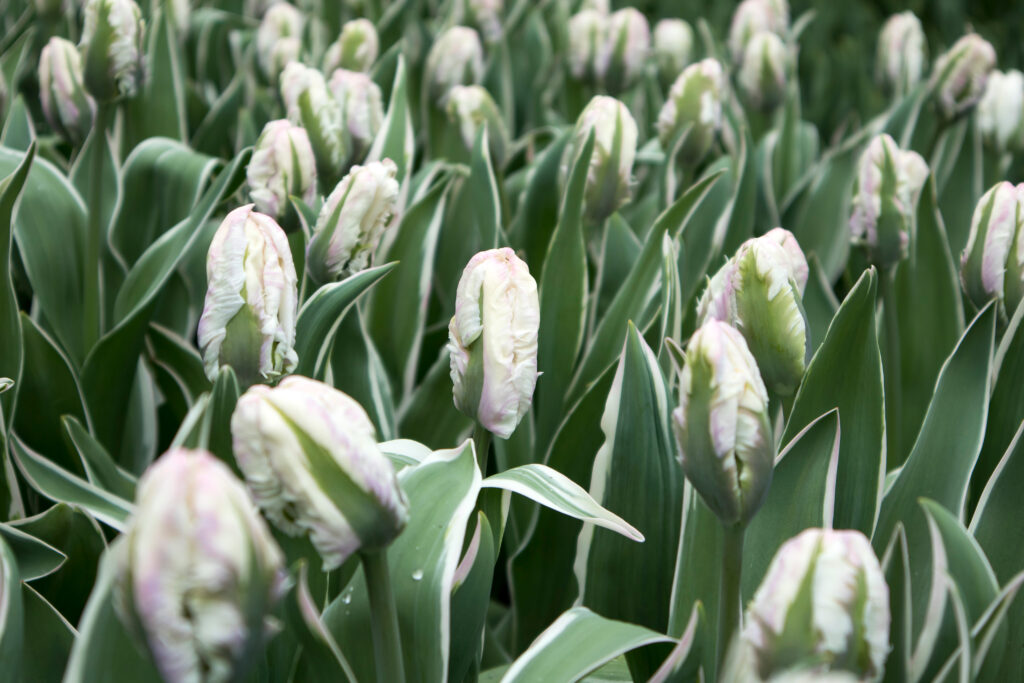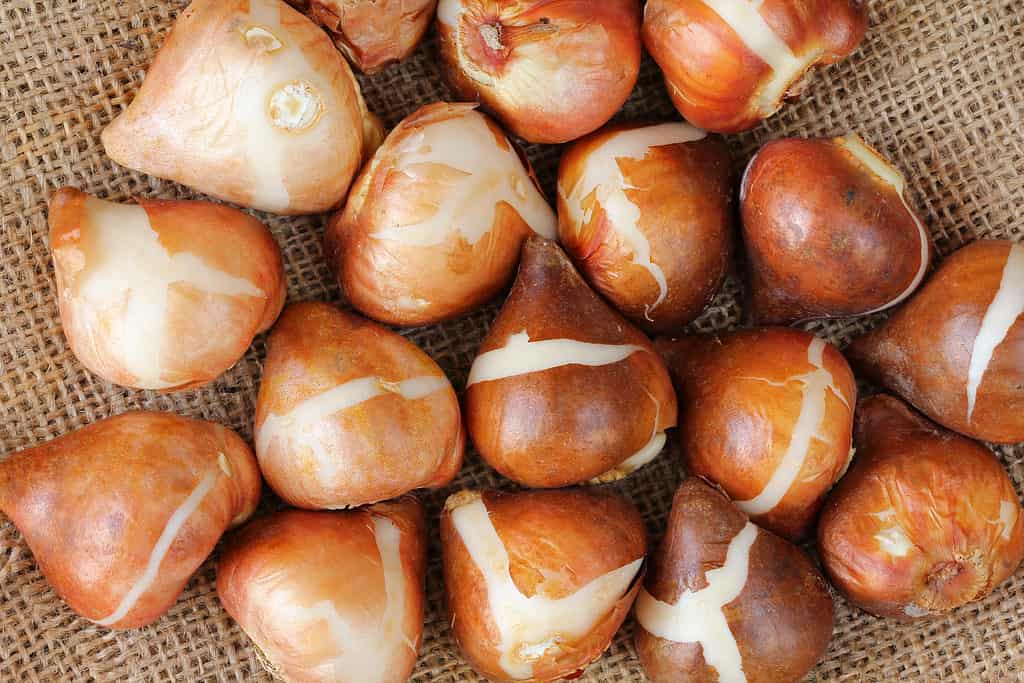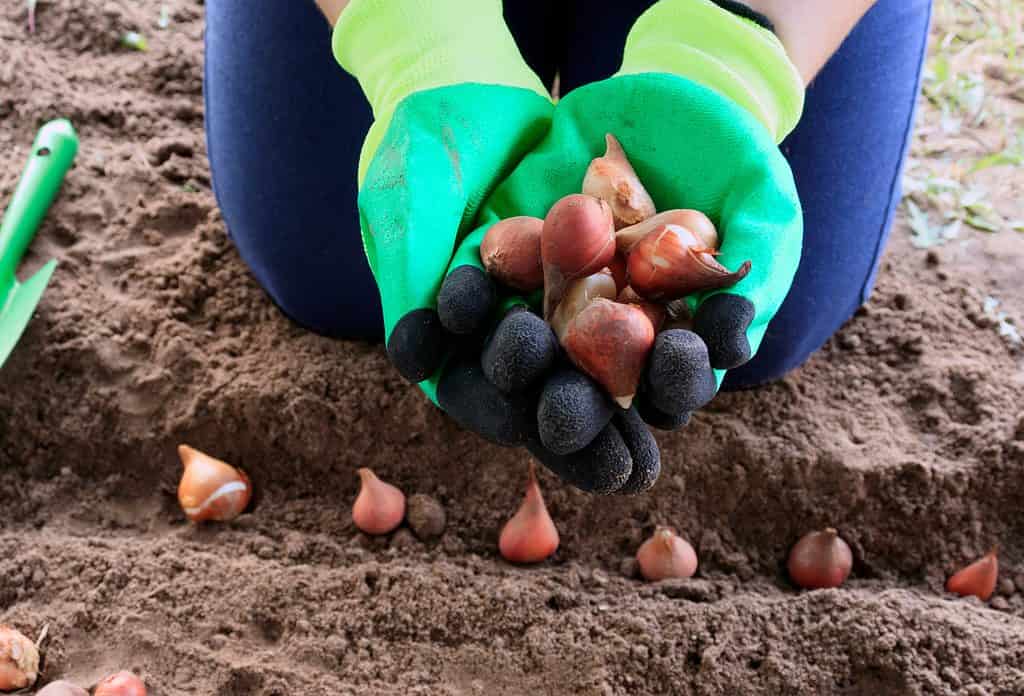Without hummingbirds and flowers, spring in Pennsylvania just wouldn’t be quite as beautiful. As the earth awakens from its winter slumber, these vibrantly colored blooms give life to our landscapes. Will you be planting tulips this year?
Do you want to know when to plant them in Pennsylvania for the best results? Here is some information on when to grow tulips in Pennsylvania. If you don’t have a green thumb, we’ve included some of the most jaw-dropping tulip fields to visit that make great photo-ops!

Tulips can bloom for up to two years before their output substantially declines.
©Elena Rostunova/Shutterstock.com
Are Tulips Perennial Or Annual Flowers?
When deciding when to plant tulips, knowing whether they are annuals or perennials is essential. The majority of the species of these bulbs no longer have the capacity to develop annually due to years of hybridization.
Tulips can bloom for up to two years before their output substantially declines. They need to be planted every autumn as annuals in the garden. You can only experience the season’s vibrant flowers in that way. So let’s talk about how and when you should plant these beauties!

Tulips should be planted in
Pennsylvania
ideally in the midst of the fall season, between early October and early November.
©Liviu Gherman/Shutterstock.com
When Should I Plant Tulips in Pennsylvania?
Tulips should often be planted in the fall, right before the ground freezes from cold weather, so they can blossom in the spring. Tulips should be planted in Pennsylvania, though, ideally in the midst of the fall season, between early October and early November.
Doing this will give the flowers time to establish roots before winter arrives. In turn, this guarantees that the tulips can blossom without incident in the spring. The quantity of flowers you will get from tulips depends on when you plant them. As previously indicated, Pennsylvania is divided into zones five through seven according to the USDA.
Residents in Zone five should plant early, around September, to give the bulbs time to grow roots because their winters are colder. There is space for cultivation in late autumn or early winter, from November to December, in zones seven because of the mild winters.
You can have a lot of leaves and stems but few blossoms if you don’t adhere to the standards for the hardiness zone. You might find it useful to focus on the hardiness zone your garden is in, especially if you’d like a lot of flowers.
Planters can only know for sure when to sow these bulbs throughout the fall by doing that. The drawbacks of early planting include the possibility of disease issues. Make sure to determine the ideal timing for your specific area.

The drawbacks of early planting include the possibility of disease issues.
©sasimoto/Shutterstock.com
How to Plant Tulips in Pennsylvania
If we didn’t discuss growing advice and methods in our article on when to plant tulips, it wouldn’t be comprehensive and we’d be doing readers a disservice. Now that you know when to plant the bulbs, you need to provide the ideal conditions for tulip growth. This bulb family is prone to rot, which is brought on by wet soil.
Tulip bulbs need to be planted in well-drained soil if you want them to mature and bloom in the spring. Tulips can also be grown in a raised bed as an alternative. This is a great way to avoid any flooding concerns.
Make sure you choose a location that receives direct sunlight. Although these bulbs thrive in the shade, sunshine is essential for their growth. Fill the soil with loose tulips. The planting area should be at least ten inches deep, with at least two inches of fertilizer added before combining it in order to have the bulbs in a loose enough planting zone.
The bulbs should be positioned at least four inches apart from one another. Plant the bulbs three times as deep as the tulip bulbs’ height, using a garden trowel. Make sure the roots are oriented downward and the area where the shoot will grow upward.
After applying compost to the surface, water the soil. Depending on how fruitful your garden is, you can add fertilizer. Something to keep in mind is that tulip bulbs are susceptible to being consumed by rodents. In the absence of a wire to hold them in place, you can insert prickly leaves into the planting holes to fend off wildlife.

The bulbs should be positioned at least four inches apart from one another.
©Natallia Ustsinava/Shutterstock.com
Best Tulip Fields in Pennsylvania
There are several ways to soak in brilliant spring tulips from all around the globe. Many fields let you bring some home if your soul is hankering for some blossoms. The flower farms and meadows in the area provide lovely views for a lot less money than taking a flight to Holland. Plus, not everyone has a green thumb and these fields still let you bask in the glory of stunning fields.

The flower farms and meadows in the area provide lovely views for a lot less money than taking a flight to Holland.
©ISmiths/Shutterstock.com
Brown Hill Farms
The biggest tulip farm in Pennsylvania today is Brown’s, which was first started in 1868 as a dairy farm. Its tulip fields, which cover five acres and contain over 400,000 tulips, are one of the most well-liked springtime destinations in the region. Furthermore, you can choose among 25,000 daffodils there to take home!
Dalton Farms
This 100-acre farm in Gloucester County contains a six-acre lake, 10 active beehives that make honey, 30 acres of tulips, and is situated on land that dates back to the 17th century. The best part? You can buy honey fresh from the hives to take home!
Throughout the brief tulip blooming season in April, the ticketed Festival of Tulips is open most weekends, dependent on the weather. These are the only weeks where you can purchase tulips for $2 a stem or $10 for a bunch of 10 stems to complete your bouquet.
Holland Ridge Farms
In nearby Monmouth County, New Jersey, Casey Jansen Sr. established a sizable family-run flower farm that was modeled after Holland’s well-known tulip farms. The biggest u-pick farm in the nation, the 300+ acre property has what seems like limitless flower fields and holds an annual tulip festival.
Around 8 million blossoms can be found in the pick-your-own tulip fields. They open in the middle of April every year. Although the tulip season is brief and only lasts for around three weeks, a stem only costs $1. Each ticket, which goes on sale about a week before the fields open, comes with free buckets and clippers from the farm.
Hershey Gardens
As you take the ideal shots, inhale the fragrant tulip meadow. After taking in the breathtaking view, explore the remaining gardens. They include a Japanese garden, a rock garden, roses, and seasonal flowers. At Hershey Gardens, you may spend a relaxing morning or afternoon pussyfooting through this tulip field.
The 23 gorgeous acres that makeup Hershey Gardens can all be explored while strolling along the one-mile, wheelchair-accessible route. See the almost 600 butterflies that call the indoor Butterfly Atrium, which also features tropical plants and a comforting water feature, home.
Longwood Gardens
One of the nation’s most renowned horticultural settings has grown out of Pierre du Pont’s 1906 ambition to prevent one of the country’s most beloved trees from becoming sold for lumber. Longwood Gardens is a 1,100-acre botanical garden. It boasts stunning landscapes, woodlands, pastures, fountains, a 10,010-pipe Aeolian organ, and a stately conservatory.
Guests can stroll through a variety of tulips during Spring Blooms. You can also see magnolias, cherry blossoms, and much more in both indoor and outdoor settings. Over 200,000 tulips and other seasonal blossoms line the 600-foot-long Flower Garden Walk at Longwood, creating a kaleidoscope of color.
Final Thoughts
These plants’ vivid colors bring a welcomed vibrancy to your yard or garden. Zones three to eight are ideal for tulips. Since Pennsylvania is in zone five to seven, they can thrive there without any issues. Mid-fall is the ideal time to grow them.
But, depending on how chilly your winters are, you are able to accomplish this in the early or late days of October. Each year, tulip blossoms should cover your garden if you grow them in well-drained soil and add compost. It’s also important to note that there are various tulip types available, each with unique blossom colors, sizes, and styles.
The photo featured at the top of this post is © Nanzyprom/Shutterstock.com
Thank you for reading! Have some feedback for us? Contact the AZ Animals editorial team.







